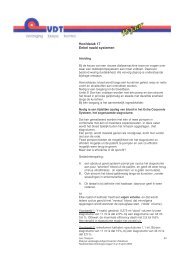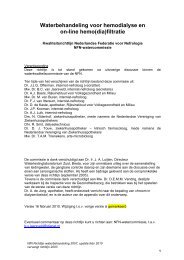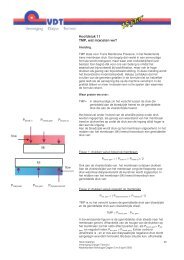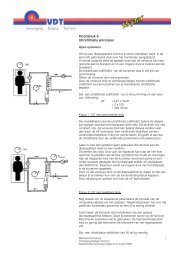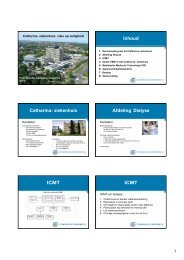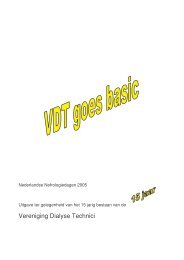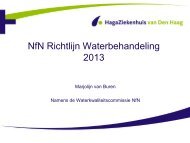Design Requirements for a Water Distribution System in a ...
Design Requirements for a Water Distribution System in a ...
Design Requirements for a Water Distribution System in a ...
You also want an ePaper? Increase the reach of your titles
YUMPU automatically turns print PDFs into web optimized ePapers that Google loves.
Philip Andrysiak, BS, MBA, CHT; Philip M. Varughese, BS, CHT<strong>Design</strong> <strong>Requirements</strong> <strong>for</strong> a<strong>Water</strong> <strong>Distribution</strong> <strong>System</strong><strong>in</strong> a Hemodialysis Center<strong>Water</strong> systems are an <strong>in</strong>tegral part of the dialysis facility. They are vital to the safe and effectivetreatment of the patient. There are a variety of components used to supply water to eachdialysis mach<strong>in</strong>e. Part of this system of components is the pip<strong>in</strong>g used to distribute this water.There are specific flow velocities required that m<strong>in</strong>imize bacterial adhesion to the pip<strong>in</strong>g system.The purpose of this article is to help with the design of a water distribution system thatwill ma<strong>in</strong>ta<strong>in</strong> adequate flow velocities throughout the entire system. This article presents a newapproach toward design<strong>in</strong>g the water distribution system <strong>for</strong> the hemodialysis center.This educational article has been especially designed to provide one (1) contact hour (CH)credit <strong>for</strong> registered nurses (RNs), Patient Care Technicians (PCTs), Biomedical and EquipmentTechnicians, and other direct-care personnel who are licensed and certified by theBoard of Registered Nurs<strong>in</strong>g (BRN) of Cali<strong>for</strong>nia. Most (not all) American states recognizeand accept the Cali<strong>for</strong>nia BRN-certified CHs. Thus, most American healthcare personnel canreceive CHs—which are applicable <strong>for</strong> recertification or relicensure—from read<strong>in</strong>g this articleand then answer<strong>in</strong>g a post-test (see sidebar). There is no charge to receive the CH credit.It is the reader’s responsibility to contact his/her BRN, its equivalent, or other certify<strong>in</strong>gbodies prior to submitt<strong>in</strong>g this post-test <strong>for</strong> CH credits to determ<strong>in</strong>e acceptability by thereader’s state and/or certify<strong>in</strong>g agency.1.0 CONTACT HOURSObjectives• To determ<strong>in</strong>e the different flow velocities needed <strong>in</strong> direct and <strong>in</strong>direct water feed systems.• To determ<strong>in</strong>e the m<strong>in</strong>imum flow velocity needed <strong>in</strong> a dialysis facility.• To understand the reason <strong>for</strong> hav<strong>in</strong>g a specific flow velocity.• To understand the quality of water needed <strong>in</strong> a dialysis facility.• To be able to specify the correct materials <strong>for</strong> use <strong>in</strong> a dialysis facility’s water distributionsystem, and to specify those materials that are not appropriate.• To understand those factors that affect the flow velocity <strong>in</strong> the water distribution system.• To be able to calculate the flow velocity at any po<strong>in</strong>t <strong>in</strong> a dialysis facility.Philip Andrysiakis a Renal Consultantbased <strong>in</strong> Homestead,Florida. Philip M.Varughese is FacilityAdm<strong>in</strong>istrator, DaVita-Richmond Kidney Center,Staten Island, New York.Ever s<strong>in</strong>ce the early days of dialysis,transport<strong>in</strong>g water has been one ofthe many challenges faced. From theorig<strong>in</strong>al batch systems with 120 L of solution,to the current s<strong>in</strong>gle-patient deliverysystems that require up to 1,000 ml perm<strong>in</strong>ute, deliver<strong>in</strong>g quality water to the patients’treatment area is still a challenge.<strong>Water</strong> systems are an <strong>in</strong>tegral part of anyhemodialysis facility. There are various mechanicalcomponents—from the pretreatment,to the reverse osmosis (RO), to the post-treatment—thatare used to provide the properquality water <strong>for</strong> the dialysis treatment. Onceit passes through the purification process, thewater needs to be distributed to the dialysisequipment. There are certa<strong>in</strong> requirements <strong>for</strong>distribut<strong>in</strong>g water to each <strong>in</strong>dividual station(dialysis mach<strong>in</strong>e, reprocess<strong>in</strong>g equipment,bicarbonate fill<strong>in</strong>g area, etc.), as well as manydrawbacks with deliver<strong>in</strong>g this large a quantityof water.OCTOBER 2002 VOLUME 31, NUMBER 10 DIALYSIS & TRANSPLANTATION 683
WATER DISTRIBUTION DESIGNOn the surface, it might appear tobe relatively easy to supply water toeach <strong>in</strong>dividual station. However, thereare requirements that need to be met <strong>in</strong>order to ensure a safe water quality.Each station requires a specific waterflow rate, along with a m<strong>in</strong>imumand maximum pressure. If only them<strong>in</strong>imum pressure and flow rate weresupplied, the result would be a verylow flow velocity. There would evenbe areas with<strong>in</strong> the supply system thatwere completely stagnant; this is especiallytrue with a direct distributionsystem (no storage tank). There<strong>for</strong>e, itis imperative to build <strong>in</strong> extra flow capacityabove what is needed, creat<strong>in</strong>ga “scrubb<strong>in</strong>g” velocity. Along withrout<strong>in</strong>e dis<strong>in</strong>fection, this will aid <strong>in</strong>prevent<strong>in</strong>g bacterial adhesion that canlead to biofilm and its consequentproblems. For this reason, there arem<strong>in</strong>imum flow requirements.Loop Flow <strong>Design</strong>Both with <strong>in</strong>direct (storage tank) anddirect feed systems, the water shouldflow <strong>in</strong> a loop. This means that the watertravels <strong>in</strong> a cont<strong>in</strong>uous circlethroughout the facility without anybranch<strong>in</strong>g off. The unused, expensivelypurified water is then returned to eitherthe RO or the storage tank and notdiscarded to dra<strong>in</strong>. Furthermore, witha loop design, along with proper pip<strong>in</strong>gsize, you can achieve higher flowrates through the system, which givehigher flow velocities.Determ<strong>in</strong><strong>in</strong>g the Loop Flow VelocityThe flow rate is described <strong>in</strong> terms ofcubic feet per m<strong>in</strong>ute. This then getsconverted to the flow velocity <strong>in</strong> feetper second (FPS). For a direct feed system,a m<strong>in</strong>imum flow velocity of 1.5FPS is required, as measured at the“end” of the loop and dur<strong>in</strong>g peak demand(all systems operat<strong>in</strong>g and draw<strong>in</strong>gwater). For <strong>in</strong>direct feed systems,the m<strong>in</strong>imum flow velocity would be 3FPS, with an average range of 3–6 FPS.If the flow velocity is too high, theremay be excessive noise <strong>in</strong> the system,as well as excessive heat, not to mentionthe <strong>in</strong>creased wear and tear andelectrical costs of runn<strong>in</strong>g the pumps atan excessive speed. Consider, however,that <strong>in</strong> ultrapure applications outside ofdialysis, flow velocities of 8–10 FPSare not uncommon.When design<strong>in</strong>g a system, it is importantto remember that the flow ratewith<strong>in</strong> the pip<strong>in</strong>g system will vary. Itwill be very high at the beg<strong>in</strong>n<strong>in</strong>g ofthe system and will decrease as thewater moves through the pipe. The reasonis that the various hemodialysisequipment demands a certa<strong>in</strong> amountof water from the loop as the waterpasses by, decreas<strong>in</strong>g the volume aseach piece of equipment collects its requirement.When design<strong>in</strong>g a systemand loop, it is imperative to take <strong>in</strong>toaccount the flow requirements of each<strong>in</strong>dividual hemodialysis mach<strong>in</strong>e,piece of reuse equipment, bicarbonatefill station, mach<strong>in</strong>e repair station, etc.The water requirements can be calculated<strong>for</strong> the best-case and worstcasescenarios by us<strong>in</strong>g the<strong>Distribution</strong> Loop Flow Analysis depicted<strong>in</strong> Table I, and which is availableon-l<strong>in</strong>e (see sidebar). For example, youcan calculate the flow velocity with thereprocess<strong>in</strong>g equipment either runn<strong>in</strong>gor with it off. You can also do the sameth<strong>in</strong>g with the bicarbonate mixer. Keep<strong>in</strong> m<strong>in</strong>d that the m<strong>in</strong>imum flow velocityis with everyth<strong>in</strong>g runn<strong>in</strong>g.Although <strong>in</strong> current practice the diameterof the distribution pip<strong>in</strong>g isconstant <strong>for</strong> the entire loop, the flowvelocity can also be ma<strong>in</strong>ta<strong>in</strong>ed by us<strong>in</strong>ga step-down approach. By progressivelydecreas<strong>in</strong>g the size of thepip<strong>in</strong>g, a higher flow velocity can bema<strong>in</strong>ta<strong>in</strong>ed <strong>for</strong> the entire loop. Thiswould also help to ma<strong>in</strong>ta<strong>in</strong> consistentpressures throughout the loop. In orderto accurately determ<strong>in</strong>e the flow velocity,you will need to know the precisediameter of the pipe, along withthe <strong>in</strong>itial feed flow rate. Install<strong>in</strong>g aflow meter at the end of the loop willallow you to verify that the system hasbeen designed correctly.A word of advice: Build <strong>in</strong> spaceand options <strong>for</strong> future expansion ofyour facility so that your brand-newwater system and loop are not obsolete<strong>in</strong> a few years and so that yourcapital <strong>in</strong>vestment is not lost.<strong>Water</strong> QualityVarious agencies either regulate orrecommend the quality of the waterthat is needed <strong>in</strong> a dialysis facility.The agencies that regulate the outpatientdialysis facilities are the statehealth departments and the Centers<strong>for</strong> Medicare & Medicaid Services(CMS; <strong>for</strong>merly the Health Care F<strong>in</strong>anc<strong>in</strong>gAdm<strong>in</strong>istration [HCFA]).They typically adopt the Association<strong>for</strong> the Advancement of Medical Instrumentation(AAMI) guidel<strong>in</strong>es.AAMI is a volunteer board that recommendspolicies <strong>for</strong> both manufacturersand end-users alike, and theirguidel<strong>in</strong>es perta<strong>in</strong><strong>in</strong>g to water qualityGlossaryFlow Rate is the Volume of water deliveredper unit of time (e.g., gallons per m<strong>in</strong>ute)Flow Velocity is the Distance that thewater travels per unit of time (e.g., feetper second)<strong>Water</strong> Pressure is determ<strong>in</strong>ed bymultiply<strong>in</strong>g the Flow Rate times theResistance (measured as psi/GPM)offered by the pipeTo convert Liters per m<strong>in</strong>ute (LPM) toGallons per m<strong>in</strong>ute (GPM), multiply by0.2642To convert GPM to Cubic Feet perm<strong>in</strong>ute, multiply by 0.1337To convert GPM to Cubic Feet persecond, divide GPM by 60 and thenmultiply by 0.1337To convert the Pipe Diameter <strong>in</strong> <strong>in</strong>chesto the Pipe Radius <strong>in</strong> feet, divide theInternal Diameter by 2, then divide theresult<strong>in</strong>g number by 12Cross-Sectional Area of the pipe isdeterm<strong>in</strong>ed by the <strong>for</strong>mula 2πr (2 x 3.14x radius of the pipe)Feet per Second = Cubic Feet per seconddivided by the Cross-Sectional Area684 DIALYSIS & TRANSPLANTATION OCTOBER 2002
WATER DISTRIBUTION DESIGN<strong>for</strong> hemodialysis can be found <strong>in</strong>the monograph, ANSI/AAMIRD62:2001. 1,2The AAMI recommendation <strong>for</strong>bacteria is less than 200 colony <strong>for</strong>m<strong>in</strong>gunits (CFU)/ml <strong>for</strong> all water used<strong>in</strong> dialysis, <strong>in</strong>clud<strong>in</strong>g the water <strong>in</strong> thedistribution system, with an action levelof 50 CFU/ml. If 50 CFU/ml is reported,then an action should be takensuch as dis<strong>in</strong>fect<strong>in</strong>g the RO and/orloop and resampl<strong>in</strong>g. For endotox<strong>in</strong>s,the AAMI recommendation is lessthan 2.0 endotox<strong>in</strong> units (EU)/ml withan action level of 1.0 EU/ml.The European recommendationsare more str<strong>in</strong>gent. The EuropeanPharmacopoeia suggests a limit of100 CFU/ml <strong>for</strong> bacteria, with an actionlevel of 25 CFU/ml. For endotox<strong>in</strong>s,the limit is 0.25 EU/ml, with anaction level of 0.0125 EU/ml.A properly designed water distributionsystem will keep to a m<strong>in</strong>imumthe stagnant areas <strong>in</strong> the distributionsystem. Along with an aggressive, rout<strong>in</strong>edis<strong>in</strong>fection of the RO and loop,this should keep the bacterial and endotox<strong>in</strong>levels with<strong>in</strong> an acceptablerange <strong>for</strong> longer periods of time.Endotox<strong>in</strong>sThe challenge <strong>for</strong> any hemodialysis facilityis to provide water that is endotox<strong>in</strong>free. Bacteria will not cross thedialyzer membrane unless there is amicro leak or unless bacteria are <strong>in</strong>troduceddur<strong>in</strong>g the reprocess<strong>in</strong>g stage.Bacteria <strong>in</strong>troduced dur<strong>in</strong>g reprocess<strong>in</strong>gare killed as a result of exposure tothe dis<strong>in</strong>fectant, but they will leave endotox<strong>in</strong>s<strong>in</strong> their wake.Endotox<strong>in</strong>s reside <strong>in</strong> the cell wall ofGram-negative waterborne bacteria.When the bacteria die, they releasethese tox<strong>in</strong>s. Endotox<strong>in</strong>s can cause pyrogenicreactions <strong>in</strong> patients (feverspikes, chills, myalgia, nausea andvomit<strong>in</strong>g, hypotension). Pyrogenic orendotox<strong>in</strong> reactions typically occur <strong>in</strong>more than one patient <strong>in</strong> a given dialysisfacility at a time. They also usuallyoccur at 1 hour to halfway <strong>in</strong>to thetreatment, though they may occur earlierdepend<strong>in</strong>g upon the amount of endotox<strong>in</strong>exposure, dialyzer efficiency,back filtration issues, underly<strong>in</strong>g <strong>in</strong>fectionprocesses <strong>in</strong> the patients, andendotox<strong>in</strong> build-up <strong>in</strong> the dialyzer as aresult of multiple reuses.In addition to pyrogenic reactions,there are well-documented chronic <strong>in</strong>flammatorydisease processes that havebeen seen <strong>in</strong> patients exposed to lowlevels of endotox<strong>in</strong>s over time; thus,the tighter standards <strong>for</strong> endotox<strong>in</strong>s.Reverse osmosis will remove molecules>200 MW, which will encompassalmost 100% of endotox<strong>in</strong>s.However, <strong>in</strong> dialysis we are not mak<strong>in</strong>gsterile water, and no water loop candeliver water that is bacteria and endotox<strong>in</strong>free. For this reason, it is a goodidea to <strong>in</strong>corporate an ultrafilter oneach hemodialysis mach<strong>in</strong>e prior tothe po<strong>in</strong>t where the dialysate enters thehemodialyzer. In this way, you are assuredof dialysate go<strong>in</strong>g to the hemodialyzerthat is endotox<strong>in</strong> free.Incorporat<strong>in</strong>g ultrafilters <strong>in</strong> thel<strong>in</strong>es lead<strong>in</strong>g to the storage tank and <strong>in</strong>the water loop will further aid <strong>in</strong> theprevention of bacteria colonizationwith<strong>in</strong> the loop. However, these filterswill reduce the flow rate and, there<strong>for</strong>e,decrease the flow velocity; thus,they have to be carefully thought outand designed <strong>in</strong>to the system. Otherpo<strong>in</strong>ts of use that require ultrafiltrationare the reuse equipment and the bicarbonatefill<strong>in</strong>g station. Ultrafilters needto be dis<strong>in</strong>fected and/or replaced on arout<strong>in</strong>e basis or they will grow bacteriaand shed endotox<strong>in</strong>—the very th<strong>in</strong>gsyou are try<strong>in</strong>g to remove!Construction ConsiderationsThe way <strong>in</strong> which the water distributionsystem is <strong>in</strong>stalled is critical andrequires attention to certa<strong>in</strong> details thata local plumber might not understand.Typically, the material of choice <strong>in</strong> theU.S. is polyv<strong>in</strong>ylchloride (PVC)schedule 80. However, there is somemovement toward more prist<strong>in</strong>e materialssuch as polyv<strong>in</strong>ylidenefluoride(PVDF), polypropylene (PPE), etc.When us<strong>in</strong>g these types of specialtypip<strong>in</strong>g, you should assure that the <strong>in</strong>stallerunderstands how to correctlyweld the material; otherwise, you mayhave wasted your money.When us<strong>in</strong>g PVC, the pipe shouldbe cut us<strong>in</strong>g an approved PVC pipe-cutt<strong>in</strong>gmethod (a PVC pipe cutter, <strong>for</strong> <strong>in</strong>stance,looks like a knife and cuts thepipe square). The pipe should not be cutwith a hacksaw, as this will leave arough edge to which bacteria can adhere.Once the pipe is cut, a chamfer<strong>in</strong>gtool should be used that will round offthe <strong>in</strong>ner and outer diameter of the pipe.Chamfer<strong>in</strong>g the edges will reduce theburrs, thus allow<strong>in</strong>g the glue to be moreevenly distributed; it will also decreasethe occurrence of stress po<strong>in</strong>ts so thatthe pipe will be less likely to crack.All solvent welds should be primedprior to the glu<strong>in</strong>g process. Primercomes both with and without a bluet<strong>in</strong>t. If it has a blue t<strong>in</strong>t, the solventweld can be <strong>in</strong>spected after it has beencompleted. Where possible, all connectionsshould be solvent welded; however,the over-use of glue should beavoided, as the excess glue can hangdown and provide places <strong>for</strong> bacteria toattach. Threaded jo<strong>in</strong>ts also should beavoided, as they will have spaces wherethere will be stagnation, thus <strong>in</strong>creas<strong>in</strong>gthe possibility <strong>for</strong> bacterial growth.N<strong>in</strong>ety-degree turns <strong>in</strong> the loopshould be accomplished through theuse of two 45-degree angles. This willprovide a more even flow through theturn and prevent the stagnation thatoccurs when a 90-degree turn is used.The connections to the stationsshould be kept as short as possible. Inthis way, when a station is not <strong>in</strong> use thestagnant areas will be kept to a m<strong>in</strong>imum.The connection to the stationshould be ma<strong>in</strong>ta<strong>in</strong>ed at as high a flowvelocity as possible. Nonetheless, itwill probably not be possible to achievethe m<strong>in</strong>imum flow velocity of the distributionloop <strong>for</strong> this short segment.You can, however, achieve the highestpossible flow velocity by us<strong>in</strong>g aOCTOBER 2002 DIALYSIS & TRANSPLANTATION 685
686 DIALYSIS & TRANSPLANTATION OCTOBER 2002Table I<strong>Distribution</strong> Loop Flow AnalysisA B C D E F G H I1 Station LPM GPM Total GPM Cu. Ft./Sec. Pipe Dia. (In.) Pipe Rad (Ft.) Area Ft./Sec.2 FEED 40.00 10.57 10.57 0.0235 0.95 0.0396 0.0049 4.783 1 0.80 0.21 10.36 0.0231 0.95 0.0396 0.0049 4.694 2 0.80 0.21 10.15 0.0226 0.95 0.0396 0.0049 4.595 3 0.80 0.21 9.93 0.0221 0.95 0.0396 0.0049 4.506 4 0.80 0.21 9.72 0.0217 0.95 0.0396 0.0049 4.407 5 0.80 0.21 9.51 0.0212 0.95 0.0396 0.0049 4.308 6 0.80 0.21 9.30 0.0207 0.95 0.0396 0.0049 4.219 7 0.80 0.21 9.09 0.0203 0.95 0.0396 0.0049 4.1110 8 0.80 0.21 8.88 0.0198 0.95 0.0396 0.0049 4.0211 9 0.80 0.21 8.67 0.0193 0.95 0.0396 0.0049 3.9212 10 0.80 0.21 8.45 0.0188 0.95 0.0396 0.0049 3.8313 11 0.80 0.21 8.24 0.0184 0.95 0.0396 0.0049 3.7314 12 0.80 0.21 8.03 0.0179 0.95 0.0396 0.0049 3.6315 13 0.80 0.21 7.82 0.0174 0.95 0.0396 0.0049 3.5416 14 0.80 0.21 7.61 0.0170 0.95 0.0396 0.0049 3.4417 15 0.80 0.21 7.40 0.0165 0.95 0.0396 0.0049 3.3518 16 0.80 0.21 7.19 0.0160 0.95 0.0396 0.0049 3.2519 17 0.80 0.21 6.97 0.0155 0.95 0.0396 0.0049 3.1620 18 0.80 0.21 6.76 0.0151 0.95 0.0396 0.0049 3.0621 19 0.80 0.21 6.55 0.0146 0.95 0.0396 0.0049 2.9622 20 0.80 0.21 6.34 0.0141 0.95 0.0396 0.0049 2.87232425262728293031WATER DISTRIBUTION DESIGN
WATER DISTRIBUTION DESIGNsmaller pipe size <strong>for</strong> this short segment.By dis<strong>in</strong>fect<strong>in</strong>g the RO, the loop,and all of the mach<strong>in</strong>es connected tothe system at the same time, you willbe able to dis<strong>in</strong>fect the connections andthe <strong>in</strong>let hoses to the dialysis mach<strong>in</strong>es,which are often neglected.The use of any metals <strong>in</strong> the systemother than a high-grade sta<strong>in</strong>lesssteel (316L) is not appropriate. Othermetals (brass, copper, alum<strong>in</strong>um) canleach <strong>in</strong>to the water and cause harmto the patient. The materials used <strong>in</strong>the system—<strong>in</strong>clud<strong>in</strong>g O-r<strong>in</strong>gs andpump seals—must be compatiblewith the dis<strong>in</strong>fectants used. Nitrilerubber, <strong>for</strong> example, is not compatiblewith peracetic acid. Where thisdis<strong>in</strong>fectant is used, the preferred materialwould be a fluorocarbon elastomeror ethylene propylene.Calculat<strong>in</strong>g the Flow VelocityThis article provides you with thespreadsheet program needed to calculatethe flow velocity of a dialysiscenter’s water distribution system.The spreadsheet program is availableon-l<strong>in</strong>e (see sidebar). An exampleof a completed spreadsheet isshown <strong>in</strong> Table I. The entries found<strong>in</strong> the various columns are the resultof mathematical derivations per<strong>for</strong>medautomatically once key <strong>in</strong><strong>for</strong>mationis <strong>in</strong>putted <strong>in</strong>to selectedcells. The net result is the flow velocity,shown <strong>in</strong> the far-right column<strong>in</strong> feet per second.Column A is the station number.Column B is the flow rate <strong>in</strong> liters perm<strong>in</strong>ute. The <strong>in</strong>itial flow rate is entered,and then the flow rate <strong>for</strong> eachmach<strong>in</strong>e is entered (which is automaticallysubtracted from the <strong>in</strong>itial flowrate). Each station’s flow rate willthen be subsequently subtracted.Column C converts liters per m<strong>in</strong>uteto gallons per m<strong>in</strong>ute. This is the gallonsper m<strong>in</strong>ute <strong>for</strong> that specific mach<strong>in</strong>e,or <strong>for</strong> the <strong>in</strong>itial <strong>in</strong>put.Column D is the total gallons perm<strong>in</strong>ute after that station.Column E converts first to cubicfeet per m<strong>in</strong>ute, and then to cubicfeet per second.Column F is the actual pipediameter <strong>in</strong> <strong>in</strong>ches.Column G converts the pipe sizefrom <strong>in</strong>ches to feet, and also convertsdiameter to radius.Column H is the cross-sectional areaof the pipe <strong>in</strong> square feet.Column I is the f<strong>in</strong>al answer—theflow velocity—<strong>in</strong> feet per second. Ittakes the cubic feet per second anddivides it by the area of the pipe.Now you can enter the specifics <strong>for</strong>your facility. What you need is the flowat the beg<strong>in</strong>n<strong>in</strong>g of the system <strong>in</strong> litersper m<strong>in</strong>ute (LPM) and the flow requirementsof the hemodialysis equipment,dialyzer reprocess<strong>in</strong>g equipment, andbicarbonate mix<strong>in</strong>g station. These willbe entered <strong>in</strong> column B.You will also need to know the sizeof the pipe <strong>in</strong> the system. Remember,all pipes will have an actual size thatis different from the stated pipe size.A 1˝ pipe, <strong>for</strong> <strong>in</strong>stance, will have an<strong>in</strong>ternal diameter of less than 1˝. Thepipe size will be entered <strong>in</strong> column F.Table I is what a 20-station facilitywould look like with a 40-LPM flow rate<strong>in</strong>to the beg<strong>in</strong>n<strong>in</strong>g of the loop, with hemodialysisequipment that uses 800 mlper m<strong>in</strong>ute. By us<strong>in</strong>g this method, youcan determ<strong>in</strong>e the flow velocity of a systembe<strong>for</strong>e you beg<strong>in</strong> construction. Youwill not have to <strong>in</strong>stall a distribution pip<strong>in</strong>gsystem and then measure the flowvelocity; you can determ<strong>in</strong>e the flow velocitybe<strong>for</strong>e construction even beg<strong>in</strong>s.ConclusionYou can have the best RO system <strong>in</strong> theworld, but if the loop is poorly designed,or if an old loop is left <strong>in</strong> place when <strong>in</strong>stall<strong>in</strong>ga new water treatment system,you will have a biofilm problem. Remember,too, that if the best-designedwater treatment system and loop are <strong>in</strong>stalledyet not properly ma<strong>in</strong>ta<strong>in</strong>ed, youwill still have a biofilm problem.A comb<strong>in</strong>ation of proper watersystem design coupled with aggressiveclean<strong>in</strong>g and dis<strong>in</strong>fection is yourbest bet aga<strong>in</strong>st bacteria build-up <strong>in</strong>the system.References1. AAMI Standards and Recommended Practices<strong>for</strong> Dialysis. Arl<strong>in</strong>gton, VA: Association <strong>for</strong> theAdvancement of Medical Instrumentation, 2001.2. Luehmann DA, Keshaviah PR, Ward RA,Kle<strong>in</strong> E. <strong>Water</strong> Treatment <strong>for</strong> Hemodialysis.Rockville, MD: U.S. Department of Health andHuman Services, Public Health Service, Foodand Drug Adm<strong>in</strong>istration, Center <strong>for</strong> Devicesand Radiological Health, 2002.POST-TEST1) Which of the follow<strong>in</strong>g areappropriate water distributionsystems?a) <strong>in</strong>direct systemsb) direct systemsc) storage tank systemsd) all of the above2) For a direct feed system, the m<strong>in</strong>imumflow velocity should be:a) 0.5 feet per secondb) 1.0 feet per secondc) 1.5 feet per secondd) 3.0 feet per second3) The m<strong>in</strong>imum flow velocity <strong>for</strong> asystem should be measured at the:a) beg<strong>in</strong>n<strong>in</strong>g of the loopb) middle of the loopc) end of the loopd) at all po<strong>in</strong>ts of the loop4) The flow velocity <strong>in</strong> a directOCTOBER 2002 DIALYSIS & TRANSPLANTATION 687
WATER DISTRIBUTION DESIGNfeed system is:a) higher at the beg<strong>in</strong>n<strong>in</strong>g ofthe loopb) higher at the end of theloopc) highest at the middle ofthe loopd) the same at all po<strong>in</strong>ts ofthe loop5) The purpose of ma<strong>in</strong>ta<strong>in</strong><strong>in</strong>gflow velocity <strong>in</strong> the distributionsystem is to:a) lower endotox<strong>in</strong>sb) reduce biofilmc) provide adequateflow to the mach<strong>in</strong>esd) all of the above6) The most common material<strong>for</strong> distribution pip<strong>in</strong>g used <strong>in</strong>dialysis is:a) polyv<strong>in</strong>ylchloride (PVC)b) polyv<strong>in</strong>ylidenefluoride(PVDF)c) polypropylene (PPE)d) none of the above7) The material that is unacceptableto use <strong>in</strong> the distributionsystem is:a) copperb) brassc) galvanized steeld) all of the above8) If the dialysate flow rate of thehemodialysis equipment is <strong>in</strong>creased,the flow velocity will:a) stay the same throughoutthe systemb) be lower at the beg<strong>in</strong>n<strong>in</strong>gof the loopc) be lower at the end ofthe loopd) be lower at all po<strong>in</strong>ts <strong>in</strong>the system after the firstmach<strong>in</strong>ee) answers c and d9) A m<strong>in</strong>imum flow velocity <strong>in</strong>the distribution system will:a) prevent bacterial adhesionb) prevent endotox<strong>in</strong> adhesionc) provide adequate flow tothe hemodialysis equipmentd) answers a and b10) The follow<strong>in</strong>g will affect theflow velocity <strong>in</strong> the distributionsystem:a) <strong>in</strong>itial flow rateb) pipe diameterc) hemodialysis equipmentdialysate flow rated) all of the above D&TObta<strong>in</strong><strong>in</strong>g Contact HoursThe certify<strong>in</strong>g agent <strong>for</strong> these contact hours (CHs) isHemodialysis, Inc. (Hi), a Southern Cali<strong>for</strong>niahealthcare corporation. Hi—<strong>in</strong> conjunction withDialysis & Transplantation—makes these CHsavailable as a free perquisite to the readers of thiseducational product. Those healthcare personnelwho wish to receive a certificate <strong>for</strong> one (1) CH arerequired to correctly answer and submit the 10-questionpost-test that can be found elsewhere <strong>in</strong> this article.All post-tests <strong>for</strong> this article must be received<strong>in</strong> Hi’s offices prior to August 16, 2004.Download from the Web: This article and the posttest—aswell as the Excel ® spreadsheet discussedwith<strong>in</strong> the article—can be downloaded directly fromHi’s Web site: www.Hemodialysis-Inc.com. A l<strong>in</strong>kcan also be found on D&T’s Web site,www.eneph.com. For any specific questions perta<strong>in</strong><strong>in</strong>gto the use of the Excel spreadsheet, contactPhilip Andrysiak at PHA160@aol.com.Disclaimer: With few exceptions, other states’ nurs<strong>in</strong>gorganizations, as well as other certify<strong>in</strong>g bodies,recognize Cali<strong>for</strong>nia Board of Registered Nurs<strong>in</strong>g(BRN) CHs. It is the reader’s responsibility to contactthose organizations to verify that they accept Cali<strong>for</strong>niaBRN CHs. We make no claim or representationthat the earned CHs are applicable outside of Cali<strong>for</strong>nia.S<strong>in</strong>ce 1998, Hemodialysis, Inc., has publishednurs<strong>in</strong>g literature conta<strong>in</strong><strong>in</strong>g CHs. These educational<strong>in</strong>struments have been purchased by dialysis and othernurs<strong>in</strong>g personnel <strong>in</strong> most, if not all, of the 50American states, as well as overseas and <strong>in</strong> Canada.Letters from purchasers whose state or country doesnot have a BRN nor a requirement <strong>for</strong> CHs have <strong>in</strong>dicatedthat employers use and value these CHs <strong>for</strong>the evaluation of employees <strong>for</strong> the purposes of promotionand salary enhancement. Thus, these CHshave substantial value even if they cannot be appliedtoward recertification or relicensure.688 DIALYSIS & TRANSPLANTATION OCTOBER 2002
WATER DISTRIBUTION DESIGNPhotocopy, Complete, and Mail This Post-Test Form To:Hemodialysis, Inc.ATTN: <strong>Water</strong> <strong>Distribution</strong> <strong>System</strong> Post-Test1560 E. Chevy Chase Dr., Ste. 435Glendale, CA 91206-4175 (USA)A self-addressed bus<strong>in</strong>ess-size envelope (9˝ x 4 1/4˝) with first-class postage affixed must be enclosed with the post-test.No request <strong>for</strong> CHs will be processed without this requirement.All Post-Tests <strong>for</strong> this educational article must be received <strong>in</strong> Hi’s offices prior to 5:00 p.m., August 16, 2004.For any questions, please call Hemodialysis, Inc., at 818/956-5357.Name (first and last) ––––––––––––––––––––––––––––––––––––––––––––––––––––––––––––––––––––––––––––––––Street Address (<strong>in</strong>clude Apt. #) ––––––––––––––––––––––––––––––––––––––––––––––––––––––––––––––––––––––––City, State, Zip Code––––––––––––––––––––––––––––––––––––––––––––––––––––––––––––––––––––––––––––––––Home Phone (<strong>in</strong>clude Area Code) ––––––––––––––––––––––––––––––––––––––––––––––––––––––––––––––––––––❒ RN ❒ LVN ❒ PCT ❒ MD ❒ PhD ❒ Other (specify) ––––––––––––––––––––––––––––––––––––––––––––––License or Certificate No.––––––––––––––––––––––––––––––––––––––––––––––––––––––––––––––––––––––––––––State of Licensure, Date of Licensure ––––––––––––––––––––––––––––––––––––––––––––––––––––––––––––––––––Post-Test Answer Form (circle the correct response)1) A B C D2) A B C D3) A B C D4) A B C D5) A B C D6) A B C D7) A B C D8) A B C D E9) A B C D10) A B C DSignature____________________________________________Date Form Sent ________________________________________OCTOBER 2002 DIALYSIS & TRANSPLANTATION 689
WATER DISTRIBUTION DESIGN690 DIALYSIS & TRANSPLANTATION OCTOBER 2002



